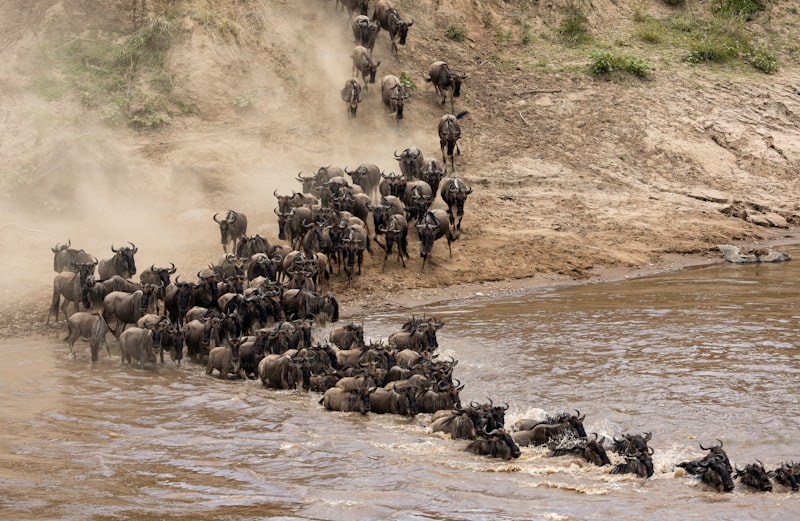Imagine the majestic monarch butterflies, embarking on a remarkable voyage from Canada to Mexico. Against all odds, these delicate creatures navigate through changing seasons and varied landscapes, guided by an innate sense of direction that remains a marvel to scientists. Each year, they return to the same sanctuaries, a testament to their uncanny ability to navigate with precision.
Not to be outdone, the awe-inspiring wildebeest of the Serengeti undertake an epic migration in search of greener pastures. Hundreds of thousands of these hoofed giants traverse vast plains and treacherous rivers, braving predators and hardships along the way. Their migration not only ensures their survival but also shapes the ecosystems they encounter, influencing everything from vegetation patterns to predator-prey dynamics.

Even beneath the waves, the enigmatic journeys of marine creatures unfold. Take, for instance, the magnificent humpback whales that migrate annually from polar feeding grounds to warmer breeding waters. These gentle giants cover thousands of miles, communicating through haunting songs that echo across the oceans. Their migration patterns remain essential for their reproduction and survival, weaving a vital thread in the tapestry of marine life.
But why do these animals embark on such arduous journeys? The reasons vary, from accessing vital resources like food and breeding grounds to escaping harsh weather conditions. Evolution has finely tuned these migrations over millennia, ensuring the continuation of species and the resilience of ecosystems.
Unraveling the Enigma: The Science Behind Mysterious Animal Migrations
Have you ever wondered how animals navigate thousands of miles across oceans and continents with pinpoint accuracy? The phenomenon of animal migration is a marvel of nature, blending biology, physics, and even a touch of magic. These epic journeys, spanning from the Arctic tern’s yearly migration from the Arctic to Antarctica, to the monarch butterfly’s incredible trek from Canada to Mexico, leave scientists and enthusiasts alike in awe.
At the heart of these migrations lies a complex web of sensory cues and biological adaptations. Birds, for instance, often rely on a combination of celestial cues from the sun and stars, magnetic fields, and even landmarks to guide their way. This intricate navigation system allows them to maintain precise migratory routes year after year.
Similarly, marine creatures such as sea turtles harness Earth’s magnetic field to guide them across vast distances. Their ability to detect geomagnetic cues helps them navigate during both migration and daily activities, ensuring they return to the same nesting beaches or feeding grounds.

But what drives these incredible journeys? Migration is often triggered by seasonal changes in temperature, food availability, or reproductive cycles. For instance, the Arctic tern migrates to the Antarctic during the Northern Hemisphere’s winter to take advantage of the summer abundance of food in the Southern Hemisphere.
Moreover, these migrations aren’t just about survival; they’re crucial for maintaining ecosystems and biodiversity. By transporting nutrients, distributing species, and influencing habitats across continents, migratory animals play a pivotal role in shaping the natural world.
In essence, animal migration is a testament to the resilience and adaptability of life on Earth. It’s a symphony of biological rhythms and environmental cues, choreographed over millennia. As we continue to unravel the mysteries behind these migrations, we deepen our understanding of the interconnectedness of all living things and the delicate balance of our planet’s ecosystems.
Secrets of the Wild: Understanding the Routes of Mysterious Animal Migrations
Imagine a solitary monarch butterfly, fluttering its way from Canada all the way down to Mexico, guided by an internal compass honed through generations of evolution. Or picture the awe-inspiring spectacle of wildebeests thundering across the Serengeti plains in pursuit of greener pastures, driven by instinct and the need for sustenance. These migrations are not mere random movements; they are meticulously planned journeys ingrained in the survival strategy of each species.
One of the most intriguing aspects of these migrations is the role of environmental cues. Animals often rely on subtle changes in temperature, day length, or magnetic fields to determine when it’s time to embark on their epic journeys. For instance, Arctic terns, known for having the longest migration route of any bird, follow a zigzagging path that takes them from the Arctic to the Antarctic and back again, covering over 40,000 miles annually. Their navigation skills are so precise that they can pinpoint their breeding grounds with astonishing accuracy.
These migrations also highlight the interconnectedness of ecosystems. As animals travel across continents, they inadvertently transport nutrients, seeds, and even pathogens, influencing the biodiversity and health of the regions they pass through. This phenomenon underscores the delicate balance of nature and the importance of preserving habitats that support these remarkable journeys.
The secrets of wild animal migrations are a testament to the resilience and adaptability of species in the face of environmental challenges. Each journey is a masterpiece of nature’s design, shaped by millennia of evolution and finely tuned instincts. As we strive to understand and protect these routes, we gain valuable insights into the interconnected web of life that sustains our planet.
From Africa to the Arctic: Tracking the Epic Journeys of Mysterious Animal Migrations
Have you ever wondered about the incredible journeys that animals undertake across continents, defying geographical boundaries and climatic challenges? From the vast savannas of Africa to the icy landscapes of the Arctic, these migrations are nothing short of awe-inspiring marvels of nature.
Picture this: a tiny songbird weighing no more than a few ounces embarks on a journey spanning thousands of miles from its breeding grounds in sub-Saharan Africa to its wintering grounds in Europe. This isn’t just a random flight; it’s a meticulously planned expedition of survival. These birds navigate using celestial cues, landmarks, and even the Earth’s magnetic field, ensuring they arrive at their destination with precision.
Not to be outdone, the majestic wildebeest of the Serengeti undertake one of the largest overland migrations on Earth. Every year, over a million of these herbivores move in search of greener pastures, covering vast distances and braving hungry predators and treacherous river crossings. It’s a spectacle that attracts travelers and researchers alike, drawn by the sheer spectacle of life and death playing out on the African plains.
But migrations aren’t confined to warm climates. In the frigid Arctic, creatures like the polar bear and the Arctic tern undertake migrations that are no less extraordinary. Polar bears, the largest land predators on Earth, roam the Arctic sea ice in search of seals, their primary prey. As the ice shifts with the seasons, so do these magnificent beasts, adapting to a changing environment that presents both challenges and opportunities.
And then there’s the Arctic tern, a seabird that holds the record for the longest migration of any animal. This diminutive bird travels from its Arctic breeding grounds all the way to the Antarctic and back again, covering a staggering distance of over 50,000 miles annually. This incredible journey ensures that the tern enjoys continuous daylight during the breeding season and avoids the harsh Arctic winter.
These migrations aren’t just about moving from point A to point B; they’re about survival, adaptation, and the relentless pursuit of life’s essentials. Whether it’s navigating across oceans, deserts, or icy tundras, these animals remind us of the resilience and determination found in the natural world.
Hidden Patterns Revealed: How Technology Is Shedding Light on Mysterious Animal Migrations
Imagine the enigmatic journey of a sea turtle, traversing thousands of miles across oceans. Previously shrouded in mystery, these migrations are now meticulously mapped using satellite tags. These tiny devices provide real-time data, revealing how these ancient travelers navigate vast expanses of water with remarkable precision.
Similarly, in the heart of dense rainforests, miniature GPS devices are unraveling the secrets of bird migrations. Birds like the Arctic Tern, known for its incredible annual journey from pole to pole, are tracked with pinpoint accuracy. These devices capture not just the routes taken but also environmental conditions encountered, offering scientists unprecedented insights into the challenges these birds face.
On land, the movements of large mammals such as wildebeests in Africa or caribou in North America are monitored using radio collars and drones. These technologies track herds over varying terrains and seasons, revealing patterns influenced by factors ranging from food availability to predator behavior.
The impact of these revelations extends beyond mere curiosity. Conservation efforts benefit greatly from understanding migration patterns. By identifying critical habitats and migration corridors, researchers can advocate for protected areas and wildlife-friendly policies, ensuring the survival of these species for generations to come.
As technology continues to evolve, so too does our understanding of the natural world. Each discovery adds a new layer to the intricate tapestry of animal migrations, painting a clearer picture of how these journeys shape ecosystems globally. With each new insight, we are reminded of the resilience and adaptability of these remarkable creatures, navigating challenges that span continents and climates.
On the Move: The Fascinating Behaviors Driving Mysterious Animal Migrations
Have you ever wondered what drives animals to embark on incredible journeys across vast distances? Animal migrations, those awe-inspiring journeys that span continents and oceans, reveal some of nature’s most captivating behaviors. From the majestic wildebeest herds of Africa to the monarch butterflies traversing North America, these migrations are not just movements but feats of survival and adaptation.
Imagine a world where millions of creatures synchronize their movements with the seasons, following ancient paths etched into their collective memory. These migrations are not random; they are meticulously planned acts of survival. Animals migrate to find better food sources, evade harsh weather conditions, or seek out optimal breeding grounds. It’s a journey driven by instinct, honed over generations, ensuring the survival of species in the face of ever-changing environmental challenges.
The wildebeest migration in the Serengeti, for instance, sees over a million animals trekking across the African plains in search of fresh grazing lands. This spectacle not only sustains the wildebeest population but also supports a vast ecosystem of predators and scavengers reliant on this annual bounty.
Similarly, the Arctic tern holds the record for the longest migration of any bird, traveling from the Arctic to the Antarctic and back again each year. This remarkable feat covers a staggering 44,000 miles round trip, showcasing nature’s unparalleled navigation skills and endurance.
What drives these animals to undertake such arduous journeys? It’s a combination of innate biological rhythms, environmental cues, and the relentless pursuit of survival. As seasons change and landscapes transform, these migrations remind us of the resilience and adaptability of life on Earth.
Intricately woven into the fabric of our planet’s ecosystems, animal migrations are more than just movements; they are vital processes that shape biodiversity and sustain life. They inspire wonder and admiration, inviting us to marvel at the mysteries of nature and contemplate our interconnectedness with the natural world.
This article aims to capture the awe and wonder of animal migrations while maintaining a conversational and engaging tone, incorporating elements like rhetorical questions and analogies to draw the reader into the fascinating world of wildlife journeys.
Frequently Asked Questions
What causes animals to migrate?
This FAQ description explains the factors that drive animal migration, focusing on natural instincts, seasonal changes, and the search for food and suitable habitats. It aims to provide a concise understanding of why animals migrate in a clear and informative manner.
How do scientists track and study animal migrations?
Learn how scientists track and study animal migrations using various methods such as satellite tracking, GPS collars, and citizen science initiatives. These methods help researchers understand migration patterns, behavior, and conservation needs.
What are the benefits of migration for animals?
Discover the advantages of animal migration and its vital role in ecosystems. Migration aids in finding better food sources, escaping harsh weather conditions, and ensuring species survival. It helps maintain biodiversity by allowing species to adapt and thrive in different habitats.
Which animals are known for long-distance migrations?
Discover which animals are famous for their long-distance migrations with our concise FAQ. Learn about the incredible journeys of species like Arctic terns, monarch butterflies, and wildebeest, and understand the reasons behind their epic travels.
How do animals navigate during migrations?
Learn how animals navigate during migrations, including the use of celestial cues, Earth’s magnetic field, and landmarks to travel long distances with precision.


